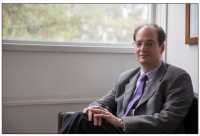19 Apr Does the Brain Generate or Passively Transmit Thoughts?
MedicalResearch.com Interview with:
Ezequiel Morsella, Ph.D.
Associate Professor of Neuroscience
Department of Psychology
San Francisco State University
Assistant Adjunct Professor
Department of Neurology
University of California, San Francisco
Boardmember, Scientific Advisory Board
Institute of Cognitive Neurology (INECO),
Buenos Aires
MedicalResearch.com: What is the background for this study? What are the main findings?
Dr. Morsella: The study is based on Passive Frame Theory, which I discuss below in brief, and on ironic processing, in which one is more likely to think about something (e.g., white bears) when instructed to not think about that thing. Based on this research, the Reflexive Imagery Task (RIT) reveals that, following the activation of certain “action sets” (i.e., dispositions to act one way or another), conscious thoughts can arise involuntarily and systematically when one is presented with certain stimuli. In the most basic version of the RIT, subjects are presented with visual objects and instructed to not think of the names of the objects, which is challenging. In the new study, we show that the effect arises not only for automatic processes (e.g., forms of cued-memory retrieval) but also for processes involving more, in a sense, moving parts (e.g., symbol manipulation, in which symbols are mentally manipulated). In the study, subjects were first trained to perform a word-manipulation task similar to the game of Pig Latin (e.g., “CAR” becomes “AR-CAY”). This task involves complex symbol manipulations. After training, though participants were instructed to no longer transform stimulus words in this way, the RIT effect still arose on roughly 40% of the trials.
The present experiment provides additional evidence for Passive Frame Theory, a new, comprehensive and internally coherent framework that illuminates the role of conscious processing in the brain. Click here for more information about Passive Frame Theory: https://www.psychologytoday.com/blog/consciousness-and-the-brain/201604/passive-frame-theory-new-synthesis
Although consciousness is not “epiphenomenal” (meaning that it serves no function) or omnipresent (e.g., as in panpsychism, which states that consciousness is a property of all matter), in Passive Frame Theory, the role of consciousness is much more passive and less teleological (i.e., less purposeful) than that of other theoretical accounts. The framework reveals that consciousness has few moving parts and no memory, no reasoning, or symbol manipulation, which is relevant to the present study. Consciousness does the same thing, over and over, for various processes, making it seem that it does more than it does. Hence, consciousness, over time, seems to be more flexible than it actually is.
MedicalResearch.com: What should clinicians and patients take away from your report?
Dr. Morsella: This striking finding is relevant to theories of cognitive control, psychopathology, and, as mentioned above, about conscious/unconscious processing. In general, the RIT findings suggest that, when regulating behavior to render it adaptive, it might be more effective, in some cases, to deal with maladaptive behaviors by weakening the processes that engender the associated urges in the first place than to deal with the urges once they are already in consciousness. This is because, if one is fatigued or mentally overburdened, then maladaptive urges in consciousness are more difficult to suppress behaviorally. This reasoning complements the research finding by others that people who are effective at self-regulation are so because they systematically avoid the situations that trigger maladaptive urges.
MedicalResearch.com: What recommendations do you have for future research as a result of this study?
Dr. Morsella: Future research can identify the limitations of these processes which generate high-level, conscious thoughts involuntarily. Such research can further reveal the unique contributions of conscious processing to nervous function.
MedicalResearch.com: Is there anything else you would like to add?
Dr. Morsella: Thank you so very much for the interview. For readers who are interested, my laboratory website has additional information about our research: http://online.sfsu.edu/morsella/index.html
Citation:
Hyein Cho, Pareezad Zarolia, Adam Gazzaley, Ezequiel Morsella. Involuntary symbol manipulation (Pig Latin) from external control: Implications for thought suppression. Acta Psychologica, 2016; 166: 37 DOI: 10.1016/j.actpsy.2016.03.004
[wysija_form id=”5″]
Last Updated on April 19, 2016 by Marie Benz MD FAAD

